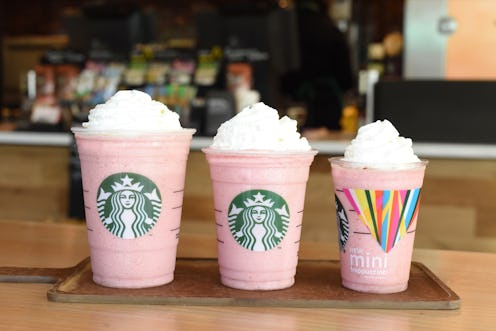
With the arrival of the Starbucks Mini Frappuccino, we now have not three, but four sizes in which to consume our favorite frozen coffee beverages this summer. But I do have some questions about it, one of which is something I'm sure has occurred to others, as well: Is the Starbucks Mini Frappuccino healthier than a regular Frapp? I don't know about you, but I think this conundrum warrants some investigation. Do I take my coffee too seriously? Possibly. But that's OK, because, well… coffee.
The simple answer is this: Yes, they're healthier, purely because they're smaller. Less Frapp means less sugar, less caffeine, fewer calories, and so on and so forth. But while the Starbucks website lists nutritional information for all menu-standard Frapp flavors for each of the three original sizes — Tall, Grande, and Venti — they haven't added the info for the Mini size. This makes a certain amount of sense; adding a whole 'nother section to the menu for an item that will only be around for a brief amount of time seems like a lot of trouble to go to for very little payoff. Still, though — it's info I feel might be worth having.
So, in an effort to do something to fill in the blanks, I did something I very rarely do: Math. I am not generally good at math, but the calculations seem to be pretty simple. All we need to do is take the information Starbucks does provide us with, use it to determine how much sugar, etc. a Frappuccino has per ounce, and then multiply the by-the-ounce figures by the appropriate number to find out what, approximately, the numbers might be for a Mini Frapp. A Mini Frapp is 10 ounces, so here, the multiplier will be 10.
Before we begin, it's worth noting that not all Frappuccinos are created equal. Some of them are more caloric and sugar-ridden than others depending on the flavor, the type of milk you use, and so on; so, to quote the Internet, YMMV (that is, your mileage may vary). For our purposes, though, let's use the standard Coffee Frappuccino as an example.
DISCLAIMER: You probably shouldn't quote me on these numbers or calculations. Think of what follows as an experiment — the attempt, possibly flawed, of one coffee-loving individual to figure out what the deal might be behind her latest obsession — not absolute fact. Have I made a mistake? Do let me know and I'll see what I can do to fix it.
What's in a 12-Ounce Tall Coffee Frappuccino?
Starbucks lists the relevant health information for a Tall Coffee Frappuccino made with two percent milk as follows:
- Calories: 170
- Calories from fat: 15
- Fat: 1.5 grams
- Saturated fat: 1 gram
- Cholesterol: 5 mg
- Total carbohydrate: 36 grams
- Sugars: 36 grams (Apparently all the carbs come from sugar, as this piece of info is a subset of the carbohydrate listing.)
- Protein: 3 grams
How Does That Break Down Per Ounce?
Since a Tall is 12 ounces, that means that, according to my possibly innacurate calculations, all those numbers per ounce breaks down as:
- Calories per ounce: 14.2
- Calories from fat: 1.25
- Fat: 0.13 grams
- Saturated fat: 0.08 grams
- Cholesterol: 0.42 mg
- Total carbohydrate: 3 grams
- Sugars: 3 grams
- Protein: 0.25 grams
So What's in a 10-Ounce Mini Frappuccino?
In order to find out the info for a 10-ounce drink, all we have to do (in theory) is multiply those per-ounce numbers by 10, one for each ounce in a Mini Frapp. That means that the nutritional information for a 10-ounce Mini Frappuccino is approximately as follows:
- Calories: 142
- Calories from fat: 12.5
- Fat: 1.3 grams
- Saturated fat: 0.8 grams
- Cholesterol: 4.2 mg
- Total carbohydrate: 30 grams
- Sugars: 30 grams
- Protein: 2.5 grams
How Much Healthier Is It?
There's a two-ounce difference between a Tall and a Mini. But do those two ounces make a difference? Not a huge one. The real danger with Frappuccinos isn't necessarily the calorie count; it's the sugar. The good news is that for dudes, ordering a Mini Frappuccino instead of a Tall puts the total amount of sugar consumed in a Frapp a little further under the American Heart Association's recommended amount for adult men (37.5 grams per day) — although bear in mind that drinking that one Frapp, regardless of size, pretty much means no more sugar for the entire rest of the day (which, given the prevalence of added sugars, isn't easy to do). And for women? We're still in the red even with a Mini Frapp: We're not supposed to consume more than 25 grams of sugar per day. Yikes.
I still maintain, though, that as long as you don't overdo it, one treat every so often isn't the end of the world. After all, every day is National Eat What You Want Day as far as I'm concerned, and maintaining a (mostly) healthy lifestyle doesn't have to be a chore. Juuuuuust sayin'. So why not try, say, making yourself a DIY S'mores Frappuccino? It's summer, after all!
Images: Starbucks; Giphy (4)